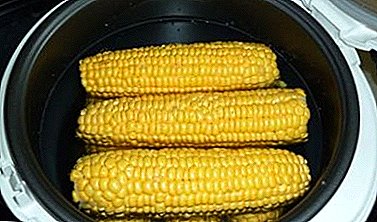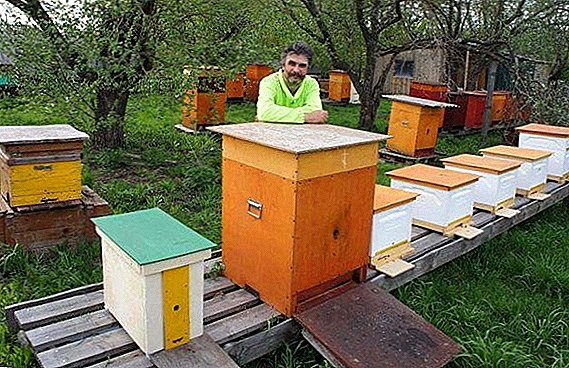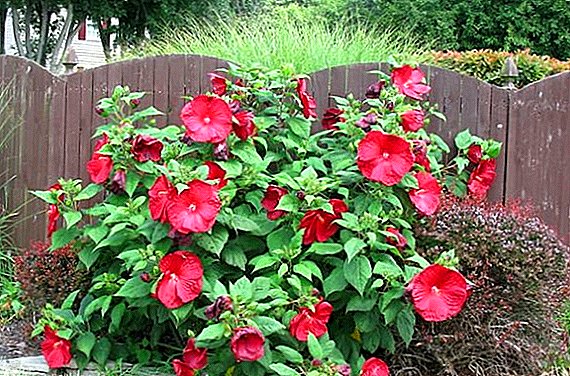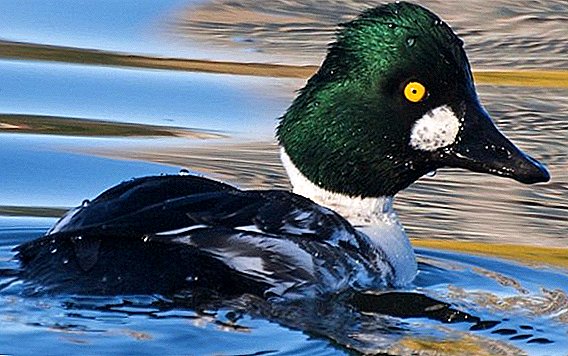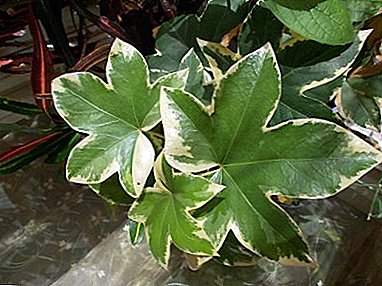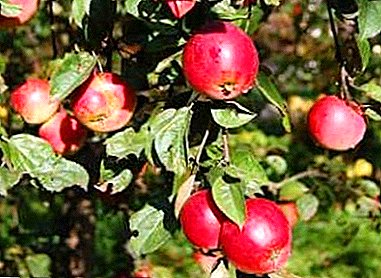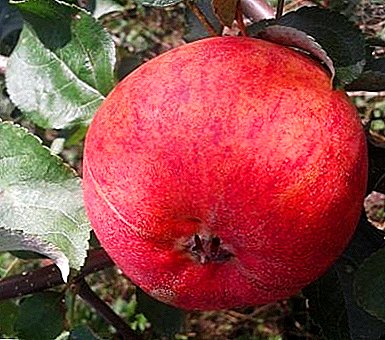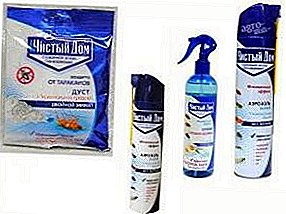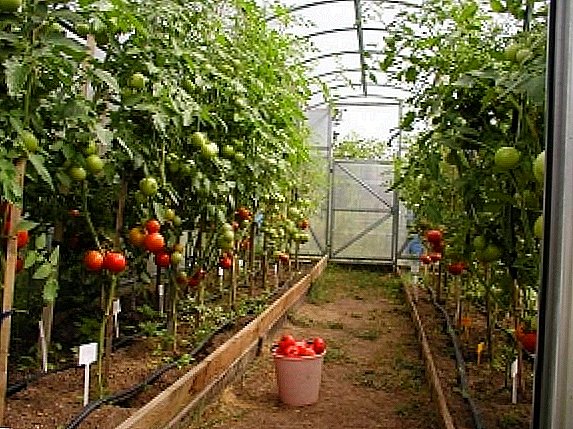
If you want to pamper yourself with fresh fruits and vegetables in both summer and winter, then the ideal option would be to grow various crops in greenhouses.
In such a protected ground can grow almost any plant, for example, tomatoes.
But there are a number of nuances that should be well studied before starting the preparation for cultivation.
You will find the most current information in this article.

A greenhouse can be constructed from polycarbonate, glass, or even from plastic film, but in all cases the place for the future structure should be well lit by the sunlight that tomatoes like so much.
To make tomatoes comfortable, you need to do good ventilation systemto avoid stagnation of air.
In the case of polyethylene walls of the greenhouse, strong temperature drops are possible at night, so you need to exert maximum efforts to protect the bushes. To this end, not one but two layers of the film are stretched onto the supports, and between these layers there should be an interlayer 2-4 cm thick.
Such an air cushion will serve as protection against low temperatures.
In this method of growing tomatoes, there are both pros and cons.
Virtues:
- indoors you can control the temperature (frost will not damage tomatoes), humidity, the amount of oxygen and carbon dioxide;
- greenhouse bushes have a higher yield than those grown in the open air;
- biological products in a limited space act better.
disadvantages:
- the construction of the greenhouse and its maintenance leads to large financial costs;
- without special treatment, various pests and diseases receive especially suitable conditions for development;
- when selling such tomatoes a large cost.
Preparation of planting material begins with the cultivation of seedlings. Seeds can be both purchased and procured independently.
If you have purchased seeds and see that they have a bright enough color (i.e., drageed), then they do not need to be processed.
In any other case, 15-20 minutes before planting, the seeds should be placed in a 1% solution of potassium permanganate. After disinfection, the seeds should be thoroughly rinsed.
As for the time for planting, then the period will be suitable. from February to the end of March. Sowing is done in special containers called cassettes.

The cassette itself consists of many compartments that need to be filled with earth. You can plant seeds in the usual low box (height 5-7 cm).
Land for future seedlings should be rich, so you need to take the sod land, peat with humus in the same proportions. Next, you need to moisten this mixture a little and add sand (1 kg to a bucket of earth), ash (1 tbsp) and some superphosphate (1 tbsp).
The finished mixture should be poured into a box, rammed, make small grooves, the depth of which should be about 1 - 1.5 cm. These grooves need pour a solution of sodium humate room temperature.
After these procedures, you can sow the seeds, which then need to fall asleep earthen mixture. The box with the future seedlings should be sufficiently illuminated, and the temperature around it should not fall below 22 ° C. After 5 after planting the box must be covered with foil. Due to this, the seeds will grow faster.
After 2 leaves grow on the shoot (this will come about on the 7th-10th day after landing), a dive should be made.
A dive is a transplant of seedlings into larger tanks.
Each seedling must be carefully removed from the box, while it is not necessary to shake the ground from the roots.
Seedlings can be kept in boxes for no more than 50 days, the length of the shoot by that moment will be about 30 cm. Stretching is typical for seedlings, that is, the shoots are long but very thin.
To avoid this, you should regularly rotate each seedling so that each side of the seedling receives enough sunlight. Before planting, seedlings can be hardened, that is, left, for example, on a balcony with open windows. This procedure can be performed about 10 days before landing.
There are many varieties of tomatoes, but not all of them will be able to give a good harvest in the conditions of the greenhouse. But among all varieties, there are varieties that are excellent fruit. For example:

- Sort "Hurricane F1"
This variety is a hybrid, it matures quickly. Fruiting begins 90 days after the seedlings have risen. Tomatoes are round, with a smooth surface and uniform coloring. The weight of one fruit can reach 90 g.
- Variety "Blagovest F1"
Early ripe variety, hybrid. Fruits are round, weighing 100 - 110 g.
- Sort "Typhoon F1"
The hybrid matures quickly (after 90 - 95 days). Fruits are round, weighing up to 90 g.
- Sort "Samara F1"
Hybrid, early variety. Fruits in 85 - 90 days after germination. Fruits have good taste, round in shape, weighing up to 80 g
- Variety "Miracle of the Earth"
Very high-yielding variety. Fruits are elongated, heart-shaped, very weighty (weight reaches 400-500 g).
Soil preparation:
Before planting tomatoes in the greenhouse, you need to ventilate the room, remove 10 to 12 cm of topsoil soil, and the rest of the land should be treated with a hot solution of copper sulphate (1 sl.lozhka 10 liters of water).
It is strictly forbidden to plant seedlings in the same greenhouse for 2 years in a row, otherwise new bushes will be infected with old diseases.
Most suitable for tomatoes loamy and sandy soils. Before planting, the soil needs fertilizer, therefore, per 1 sq.m. 3 buckets of peat, sawdust and humus mixture (proportions 1: 1: 1) should be added to the land. In addition to organic fertilizers, minerals are also needed. It is necessary to make superphosphate (3 tablespoons), potassium sulfate (1 tablespoons), potassium magnesia (1 tablespoons), sodium nitrate (1 tsp) and ash (1 - 2 cups).
Among other things, tomatoes do not like "neighbors" very much, so you should divide this room with film partitions, which will provide a separate microclimate for each type of plant.
Landing pattern:
The beds for tomatoes should be prepared in advance, they should be 25 - 30 cm in height and 60 - 90 cm in width. For passes you can leave about 60 - 70 cm. But the planting scheme directly depends on the type of tomato and the characteristics of its bush.
For example, in undersized varieties that ripen quickly, 2–3 shoots are formed, so they should be planted in two rows, observing chess order, with two bushes to be placed 35 cm apart from each other.
In shtambovy tomatoes 1 shoot is well developed, therefore, it is possible to plant seedlings more densely, but not too much. The distance between two neighboring bushes should be about 25 - 30 cm. Tall varieties need more space, therefore, they need to be planted every 60 - 70 cm.
Go to the landing of tomatoes

If it is time to move the seedlings to the ground of the greenhouse, then you must first check whether you can plant tomatoes at this time or better wait.
Firstly, the soil should be well heated, and to be more precise, to a temperature of 12-15 ° C. If the temperature of the soil is lower, then there is a risk that the roots of the seedlings will rot. In order for the ground to warm faster, it must be covered with black polyethylene.
Secondly, the stalks of seedlings should not be very immersed in the ground, otherwise all the forces of the future tomato will go to the formation of new roots, and not growth.
Thirdly, in the soil should not be an abundance of nitrogen, that is, you can not make fresh manure, chicken droppings, urea. Otherwise, foliage will grow, but there will be no fruiting.
Fourth, it is imperative to monitor the plants so that there is no damage. Any yellowed or diseased leaf should be removed.
When planting you need remove cotyledon leavesthat are near the ground, and even below. Choose a day to make it overcast, or land in the evening. The wells must be disinfected, that is, a strong, hot solution of potassium permanganate is poured into each hole, and right before planting the wells must be moistened.
It is also interesting to read about the early varieties of apples.
Greenhouse tomato care tips
- Top dressing
- Watering
- Temperature
- Pruning
- Prevention, treatment of diseases
One and a half to two weeks after planting, the tomatoes should be fertilized for the first time. This dressing will consist of nitrophoska and mullein (for 10 liters of water 1 tablespoon of nitrophos, 0.5 liters of liquid mullein). This solution is boring for 1 l per 1 bush.
After 10 days you need to make a second dressing. This time we need potassium sulfate and fertility fertilizers (for 10 liters 1 tsp of sulphate and 1 tbsp of fertilizer). This dressing should be done 3 - 4 times per season.
For tomatoes, a surplus of moisture in the soil is destructive, otherwise the fruit will simply disappoint you with its appearance and taste. Therefore, it is necessary to water the bushes with an interval of 5 - 6 days.
The first 10 days of tomatoes, too, is not desirable watering, because by that time the plants have not yet taken root in the new territory. Also important is the water temperature - 20-22 ° C.
The optimal amount of water before flowering is 4 - 5 liters of water per 1 sq. M.
When the bushes bloom, then the volume of watering should be increased to 10 - 13 liters per 1 sq.m. Water is better to pour at the rootso that the leaves and the fruits themselves remain dry.
Among other things, the best time of day to replenish moisture in the soil is morning and not evening, since in the evening there is a tendency to condensation.
For tomatoes, the right temperature is very important, otherwise they will not bloom, and then bear fruit. Therefore, if it is sunny outside, then the air should be heated to 20 22 ° C, and if the weather is overcast, then the temperature will be 19-20 ° C.
It is necessary to maintain the temperature balance at night, otherwise, any fluctuations in temperature will cause irreparable harm to tomatoes.
At night you need to maintain 16 17 ° C. This temperature is suitable for tomatoes that do not bloom yet. Further, it is impossible to cross the line of 26–32 ° C, otherwise tomatoes will not yield a crop.
The bottom line during flowering is 14 16 ° C. Tomatoes are characterized by a surge in growth of the vegetative mass, which will be to the detriment of the future harvest. If this happens, then the temperature should be kept at 25 26 ° C.
When you removed the first fruits from the bushes, then the optimum mark on the thermometer will be 16–17 ° С. This decrease in temperature will help to stabilize the process of growth and ripening of fruits.

Pruning tomatoes in the greenhouse is to remove the so-called stepsons (lateral shoots that develop from the leaf bosom). On these shoots grow leaves that block the access of sunlight to the fruits themselves.
Remove stepsons need to regularly. The bush itself must be formed from a central shoot, on which you can leave 5 - 6 brushes.
You also need to pinch the top of the bush for about a month before the end of the growing season. When the fruits begin to turn red, you need to remove all the lower leaves. Pruning should be carried out in the morning so that the “wound” places can dry out in a day.
"Sick" can both seedlings and adult bushes. For seedlings typical disease blackleg.
This fungus infects seedlings from which nothing can grow as a result. To prevent this disease, you need to change the ground in the greenhouse before planting. The most common disease for tomatoes is phytophthora.

This disease "hits" the leaves, they turn black and die. As a result, you can lose about 70% of your crop.
Against this disease it is necessary to process the bushes three times: 3 weeks after the seedlings are moved to the greenhouse ground, 20 days after the first treatment and after the beginning of flowering of the third brush on the bushes.
The treatment is carried out with solutions of the drugs "Barrier" and "Barrier" (operation according to the instructions).
The third treatment is carried out with garlic solution.
These simple tips will help you to get a wonderful crop of tomatoes at any time of the year without loss.
Good luck!


